The UK’s biggest housing association is using 3D modelling to plan its asset management and create fire safety case reviews. Will Mann reports.
The Grenfell tragedy of 2017 left landlords around the UK grappling with fire safety and how to manage their built assets.
Clarion Housing is the country’s largest housing association with 125,000 properties nationwide. In the wake of Grenfell, the association decided that 3D modelling was an effective way to capture asset information about its housing stock and create the fire safety case reviews required by the Hackitt report.
Clarion recently completed its first safety case review, for a Kent tower block, starting with a laser scan and then building a 3D model and database of asset information.
“Our 3D modelling approach meets the requirement of the Hackitt Review to have a ‘golden thread of information’ for each high-rise residential block, and allows our team to tag significant asset data,” explains Dan Hollas, fire safety projects director at Clarion.

Our 3D modelling approach meets the requirement of the Hackitt Review to have a ‘golden thread of information’ for each high-rise residential block.– Dan Hollas, Clarion
The housing association has carried out a considerable amount of fire safety remediation work since Grenfell (see below). But Hollas and his 22-strong team with responsibility for fire safety at Clarion have been thinking beyond upgrades to individual buildings.
“The social housing sector tends to wait for central guidance, but we like to be more proactive,” says Hollas. “Dame Judith Hackitt’s interim reportin December 2017 gave us a good steer on where things were going. Our biggest interest was the digital record and how this could shape our approach to asset management.”
The test case was the 1960s-built Bekesbourne Tower, a 12-storey concrete frame block in Orpington, Kent.
“There was limited information about its original design and construction or subsequent upgrade work,” says Martin Grossmith, fire safety surveyor at Clarion. “Data collection and management have never been great in social housing. So with Bekesbourne, we felt we had the perfect chance to demonstrate how to do it properly.”
Initially, Clarion obtained a quote of £12,000 to create measured drawings for the whole tower. “These were just 2D drawings that we felt would have limited future use regarding building safety and asset management, and would likely be stuck in a file and never looked at,” says Matthew Lewis, senior technical manager at Clarion.
“Then we went to Digital Construction Week in October 2018. We spotted a Leica laser scanner and thought it could do a much better job.”
The Leica BLK360 scanner, which costs around £18,000, was hired by Clarion from survey specialist SCCS for £800 a week. “It takes laser measurements and photogrammetry at the same time, creating a point cloud which is accurate to 1mm over 60m,” explains Hollas.
With no previous experience, Clarion scanned Bekesbourne in just four days. “We work with PRP Architects, who are specialists in social housing, and when we showed the results to them they were amazed,” says Grossmith. “Our 3D modelling knowledge was limited, so PRP helped us turn the point cloud into a model of Bekesbourne in Revit, through Autodesk ReCap.”
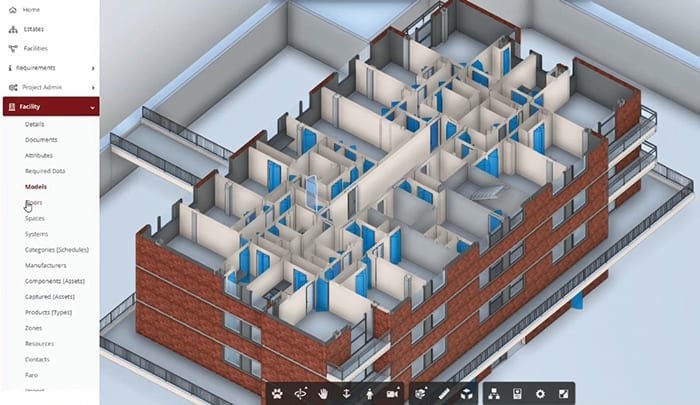
Clarion’s Bekesbourne Tower seen in ActivePlan, with fire doors selected
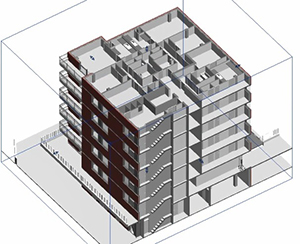
3D model section of the Bekesbourne Tower
Clarion’s plan was to use this as the basis for the tower’s safety case review, and ultimately to monitor asset condition, plan repairs, find replacement parts – essentially the future investment strategy for the building. The issue now was finding the software solution that would make this a reality.
“You can load all the asset information into Revit but it’s not very efficient,” explains Lewis. “Instead, we have a database behind the model. So, for example, with Revit we would have to tag all doors individually. With the database, you only have to tag the doors once and the information can be copied across automatically.”
The database has been created by consultant ActivePlan. Though still a work in progress, the combined model and database allows a user to view high-resolution photographs of the whole tower and zoom in on tagged assets to find out key information.
“You can click on taps and kitchen units and find out who manufactured them,” Lewis explains. “Click on a fire door, and it will tell you the specification. We’ve never had that level of granular detail about our assets.”
The model can also track irregularities. “Bekesbourne had a warm air system taken out so there is a void there,” says Hollas. “That was picked up by the scan, giving us an understanding of the network of redundant ducting and the possible risks.”
Not everything has been modelled yet. “To create floor plans, we only need to look at one of the four flats per floor,” says Hollas. “But tenants make alterations in their flats, which we can only see when they’re voids. So we need a process for getting access and finding out if, for instance, they’ve made any changes that may make a fire risk.
As well as the asset data, the 3D model offers fly-throughs of communal areas and escape routes, to help building management and to provide information for residents.
Clarion plans to implement this digital modelling on all its 70 high-rise residential buildings in the immediate term – it recently scanned Clare House in east London – and eventually on all its 125,000 flats and houses. Every model will be ‘live’, updated with any building alterations, and these will inform the safety case reviews for each property.
“We’ve started this journey with ActivePlan but we’re looking at the wider market to see what else is available,” says Hollas. “We have seen it being done in Scandinavia, where they have laser-scanned all their tower blocks and created digital records, in a way that meets our needs.”
The question for Clarion is – what level of detail should the model and database run to?
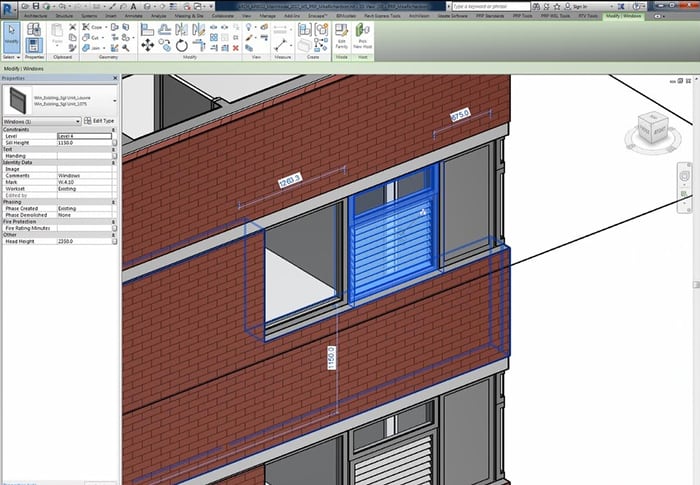
The Bekesbourne information was loaded into a 3D Revit model
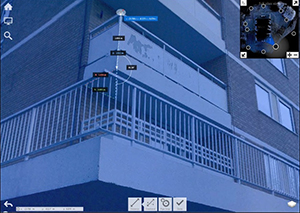
The Bekesbourne Tower was scanned using the Leica scanner
“It’s a grey area which wasn’t spelled out in the Hackitt report,” Hollas says. “We know a fire safety case review will be required for all buildings. But Bekesbourne’s model, when complete, will run to hundreds of thousands of components. Repeating that across our entire portfolio is a huge amount of work.
“Obviously fire safety equipment, and anything related to fire safety, will have to have a very tight specification. With something like kitchen units, perhaps we only need detail about the sizes. But this is a decision still to be made.”
This is also an important consideration for Clarion’s development work, as well as its existing stock. “The development side is focusing on collating as much information as possible through BIM, but when we meet in the middle, we need to be sure what they’re doing fits into our asset management system,” says Hollas.
Clarion spends over £100m a year on repairs and maintenance and all contractors will have to provide digital information “in the format we want”, says Hollas.
“But we will work in partnership with them,” he adds. “Tying down data requirements is the hard bit; there needs to be an industry standard. We got quite excited about the photos in the model at first. But then we saw the potential of the data. That can be transformative.”
Hollas says Clarion’s work on the digital models has been time-consuming but the financial investment has been minimal. “It’s the salary of our team, plus hire of the scanning equipment, which totals about £10,000,” he says. “Clarion is committed to any investment we want to make, which might include buying a scanner, or we may outsource that to a contractor.”
Next steps for the association are trialling software and then building up its models, asset data and safety case reviews through 2020.
Clarion’s fire safety remediation works
A multi-million-pound programme addressing buildings at risk.
While Grenfell has been a wake-up call for the whole housing sector, Clarion had already identified fire safety as a significant safety risk it in some of its stock.
“Clarion was formed from a merger between Affinity Sutton and Circle Housing in 2016, and shortly after we identified about £12.5m-worth of fire safety work that was required, which was approved the April before Grenfell,” says Hollas.
After Grenfell, fire safety assumed even greater priority. “We identified 116 buildings over six storeys with fire safety risks,” explains Hollas. “We got a fire safety programme up and running by September, with specifications ready for 24 buildings above 10 storeys. This meant a further £6m-worth of work, including fire stopping, AFDs [automatic fire detection systems] and fire doors. We then repeated this for buildings with six to nine storeys.”
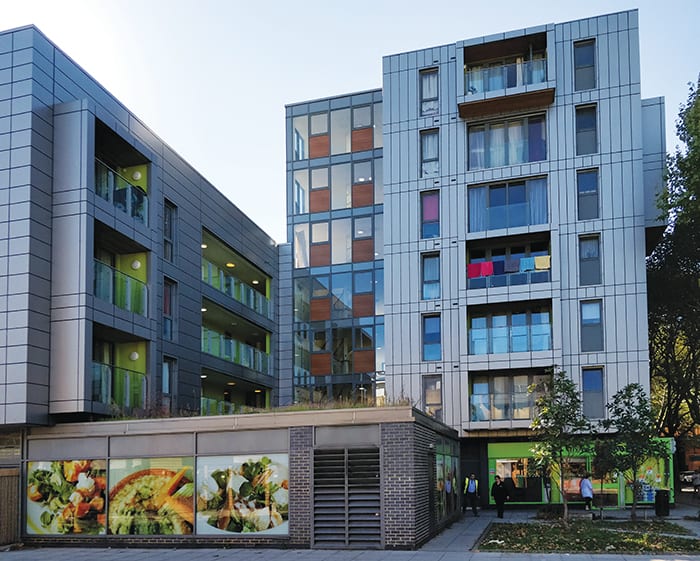
Clarion’s Messenger Court before ACM remediation
The association has its own rigorous fire safety protocols which often go above industry standards. “We have only used timber doors inside, not composite, since 2016,” says Steve Kallagher, senior fire safety programme manager at Clarion. “Doors also have to be tested on both sides, and primary tested. Fire stopping is checked by third parties.”
Between June and March 2018, the housing association spent another £12m on fire safety work. It has since spent another £20m, including cladding remediation, though only one Clarion tower was found to have the ACM (aluminium composite material) used on Grenfell: Messenger Court in Bermondsey, south London, though it is technically just under the government’s 18m threshold at 17.95m tall.
“The Messenger remediation work was carried out by Lawtech, a cladding specialist – we prefer not to use tier 1s for this type of specialism,” says Hollas.
The work cost around £900,000 and took around a year, completing in August 2019. The cladding was replaced with panels which have an A2-s1 d0-rated rainscreen with mineral fibre insulation.
“When we took the ACM cladding off, we found a lot of the cavity barriers had not been fixed in the right place,” says Hollas. “It was a slow process which we learnt a lot from.
“Talking to the wider social housing industry, wherever cladding has been taken off, there has been a 100% failure rate.”
Combustible ACM panels have also been found on other buildings, including the Bekesbourne Tower in Orpington, where they were fitted during a 1995 windows replacement.
“These works included spandrel panels spanning the party walls,” explains Hollas. “We found out these were ACM panels with a polystyrene core. We also found voids behind the panels, of 60mm-70mm, with no stopping at all. When we removed them, you could see through to the flat next door.” These were replaced by Lawtech using rope access.















